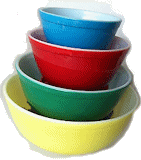Collectible Vintage Pyrex Kitchenware
 First in clear glass in 1915, and then later in a variety of colors and patterns, Pyrex brand glassware, perhaps the most recognizable of all US made kitchenware, has been in existence for over a century now. By only its fourth year of production, Pyrex, in its original clear glass form, had sold a staggering 4.5 million pieces. Introduced the mid-1940s, and ubiquitous in home cooking arsenals for the next half century, Pyrex Color Ware added a pop of color and style to any kitchen.
First in clear glass in 1915, and then later in a variety of colors and patterns, Pyrex brand glassware, perhaps the most recognizable of all US made kitchenware, has been in existence for over a century now. By only its fourth year of production, Pyrex, in its original clear glass form, had sold a staggering 4.5 million pieces. Introduced the mid-1940s, and ubiquitous in home cooking arsenals for the next half century, Pyrex Color Ware added a pop of color and style to any kitchen.
Collecting Pyrex kitchenware as a hobby can be quite enjoyable. While the early, clear Pyrex ware certainly qualifies as collectible, it is primarily the opal glass color ware and its decoratively patterned pieces dating from the 1950s and later that collectors covet. The myriad variations of color, shape, and decoration produced mean there is likely something to appeal to most every enthusiast.
And it may also be that variety which-- besides being intriguing-- makes collecting Pyrex kitchenware in some ways quite daunting. It is not a hobby for the completist, for a museum would almost be necessary to house and display every known variation.
At least one collector has tried, though. In 2002, Dianne Williams, aka "The Pyrex Lady", set about collecting every piece of Pyrex offered in Corning retail catalogs from 1915 to 1983. By 2009, only a handful of pieces eluded her search. In 2010, her collection, including all the Pyrex ephemera she had amassed, plus her manuscript for an unpublished Pyrex collector guide book were acquired by the Corning Museum of Glass for its collection and archives.
When found in very good condition, even the most mundane mixing bowls can command a handsome price as collectibles, with the primary color 4-bowl sets seen priced in the neighborhood of $80 to $100 in antique stores. With perseverance and a little luck, however, individual pieces can often be found for just a few dollars at garage sales or flea markets.
The real trick, however, is finding vintage Pyrex both at a good price and in good condition. As colorful as they were and are, they were still primarily utility pieces in mid-century kitchens. And, over and above everyday nicks and scratches, the mortal enemy of these otherwise sturdy, heat resistant vessels lay in the form of that modern convenience, the automatic dishwasher and its phosphate-laden detergent. Pieces that were hand washed could retain their color and luster for decades; the finish of those regularly run through the dishwasher soon became faded, hazy, and rough. Collectors of vintage Pyrex ware, therefore, look for those examples that were well-cared for or saw minimal use.
Fortunately, however, it appears a great deal of it was reasonably well-treated, and survives to be appreciated and enjoyed again by collectors.








